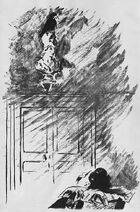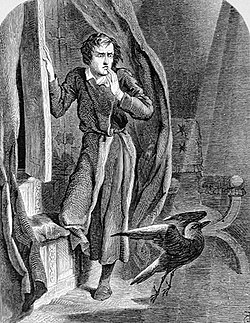
1875 illustration by Edouard Manet for a French translation of "The Raven".
The Raven is a poem by Edgar Allan Poe. It was first published in The Evening Mirror on January 29, 1845, and quickly became popular despite mixed critical reception.
In the poem, a man mourning his lover is visited by a talking raven. His initial amusement quickly turns into despair as the bird's melancholy utterance of "Nevermore" leads him deeper into depression.
In an 1846 essay "The Philosophy of Composition," Poe explains how he constructed the poem "with the precision and rigid consequence of a mathematical problem" to appeal to both popular and critical tastes, with what he determined was the most poetically melancholy topic possible; the death of a beautiful woman.
"The Raven" is considered one of the most famous American poems ever written. It is often anthologized and frequently referenced in popular culture.
Summary[]

"Vainly I had sought from my books to borrow surcease of sorrow - sorrow for lost Lenore". 1884 illustration for "The Raven" by the French artist Gustave Doré.
On a dreary December night, the narrator seeks relief in books from his sorrow over the loss of his lover, Lenore. As he nods over obscure books at midnight, he hears a gentle tapping noise at the door. Trying to convince himself it is just a late-night visitor, he opens the door to darkness. Standing there in the silence wondering and fearing, he begins to imagine it was the spirit of his lover. He whispers her name and hears it echo back.
Returning to his chamber, the narrator hears a louder tapping. He realizes it is at his window and opens the shutter. A stately Raven flies in and perches on a bust of Pallas above the door. His fear and sadness turning into amusement, in jest he asks the Raven for its name. The bird replies "Nevermore." The narrator at first marvels at the response, but when the bird says nothing more, the melancholy word begins to affect him. He mutters his forlorn thoughts aloud, resigned that the bird will leave him in the morning as his friends and hopes have done before, and the Raven repeats "Nevermore" in response. Startled by the apt reply, the narrator reasons out that the bird must have learned the one word from its unhappy owner. Still fascinated, he pulls up a chair to sit near the bird.
As he ponders the meaning of "Nevermore" uttered by the bird, his thoughts soon return to Lenore. Thinking out loud, he wonders if perhaps God sent the Raven as a sign for him to forget her - but the Raven responds "Nevermore." Agitated, he calls the bird a "thing of evil." He begins to question the Raven, deliberately forming queries to fit the expected reply. Tormenting himself with his sorrow, he asks increasingly distressing questions of the bird until finally he asks if he will see Lenore again in Heaven. Distraught at the Raven's reply, he demands the bird to leave and take its beak out from his heart. But the Raven still sits, casting a shadow on the floor and on the narrator's soul. His soul "shall be lifted - nevermore" from the shadow of depression.
Composition[]

1858 illustration for "The Raven" by the British artist John Tenniel.
Poe describes in "The Philosophy of Composition" the methods he employed in composing "The Raven." According to the essay, Poe first determined the proper length of the poem, about one hundred lines, to sustain the excitement and allow reading in one sitting. Then he selected the impression to be conveyed, that of Beauty (which he defined not as a quality but as the elevating effect on the soul of contemplating the "beautiful"), and the poetical tone of melancholy.
For artistic effects, he wished to use a refrain. In order to allow variation in the application of the refrain, he required a single word - preferably containing the long o, a sonorous vowel, in connection with r as the most producible consonant. He selected "Nevermore" as fitting both the sound and the melancholy tone desired. Having selected the word, Poe then had to come up with a pretext for the continuous use of the word. The idea came to him to use a non-reasoning creature capable of speech, and the Raven was his natural choice in keeping with the intended tone.
Next addressing the topic of the poem, Poe reasoned that the most poetical of melancholy topics must closely ally itself to Beauty, and therefore concluded that the death of a beautiful woman was the most poetical topic in the world. It then followed that the poem should be narrated by a bereaved lover. By having the Raven repeat "Nevermore" in answer to the questions posed by the lover, Poe saw the opportunity to make the queries progressively more serious, reflecting the changes in the narrator's state of mind as he indulges in self-torture.
Then Poe proceeded to establish the climax; the ultimate query to which the reply of "Nevermore" should cause the utmost amount of sorrow and despair. In composing the concluding stanza first, Poe was also able to settle the rhythm, meter, and the structure of the stanzas. With the denouement in place, he then went back to set the location and the manner of introducing the Raven to the protagonist. He preferred the confinement of a chamber to an outdoor setting, and so made the night tempestuous to account for the Raven's seeking admission. In calculated contrast, he gave early stanzas an air of the fantastic, before turning the tone serious leading to the climax.
Having completed the narrative, Poe then added the last two stanzas to elevate the poem artistically, giving it the undercurrent of meaning. He points out that "from out my heart" is the first metaphorical expression employed in the poem, and that the Raven is shown, in the very last line, to have become the emblem of mournful, never-ending Remembrance.
See also[]
- Sound file of a recitation of Edgar Allan Poe's "The Raven"
- "Annabel Lee"
- "The Bells"
- "The City in the Sea"
- "The Conqueror Worm"
- "The Haunted Palace"

